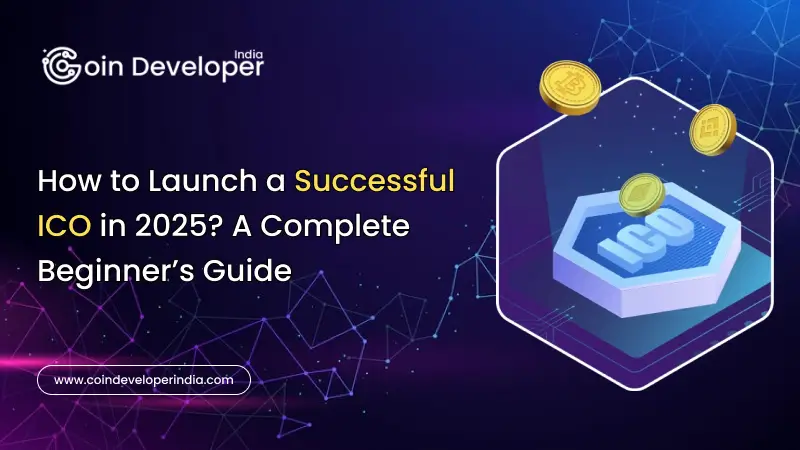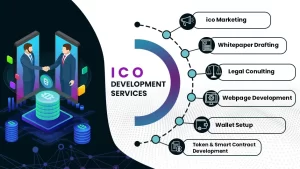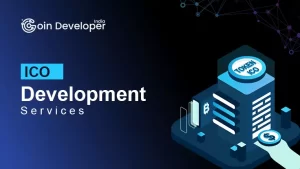In 2025, the world of cryptocurrency continues to evolve—faster, smarter, and more regulated.
According to CoinGecko, almost $4.8 billion has been raised through ICOs globally in 2024 alone. This makes it clear that ICOs are a powerful tool for blockchain startups to raise funds.
But launching a successful ICO today isn’t as simple as you think it could be. From building trust to complying with regulations, it takes a strategic plan to stand out in this competitive market.
Are you looking to launch an ICO? Here’s a guide for you! In this, we’ll talk about every step involved in launching an ICO in 2025.
Let’s have a look!
Understand What an ICO Is

ICOs, or Initial Coin Offerings, are a type of fundraising method that startups and blockchain-based projects use to raise capital. Through ICO trading platforms, investors get tokens in exchange for their monetary investment.
The token investors receive acts like a unit of currency that gives them access to certain features of the project. Investors either have the option to cash out their investment once the project is in the market or hold on to the coins until they get a significant return.
How Does an ICO Work?
An ICO is a way for a crypto project or startup to raise funds by creating and selling its own digital token to investors. Here’s how it works:
- Project Idea & Token Creation:
A team comes up with a blockchain-based project—like a new DeFi platform, game, or utility app. They create a custom token that will be used within their ecosystem.
- Whitepaper & Website Launch:
The project then publishes a whitepaper, which is a detailed document that explains the idea, the team, the technology, the purpose of the token, how the funds will be used, and the roadmap. They also launch a website for visibility and investor interest.
- Pre-Sale & Public Sale:
The ICO often starts with a pre-sale that attracts early investors at discounted rates. Then comes the public ICO, where anyone can buy tokens using crypto or fiat money.
- Token Distribution:
Investors receive the tokens in their wallets. These tokens may have immediate or delayed utility, which depends on the project.
- Exchange Listing & Project Development:
After the ICO, the team focuses on building the product. If the project gains enough attention, the token might get listed on crypto exchanges, which makes it tradable.
Benefits of Launching an ICO
Today, ICO has become a great choice for entrepreneurs and investors. Let’s take a look at some of the compelling benefits of ICOs:
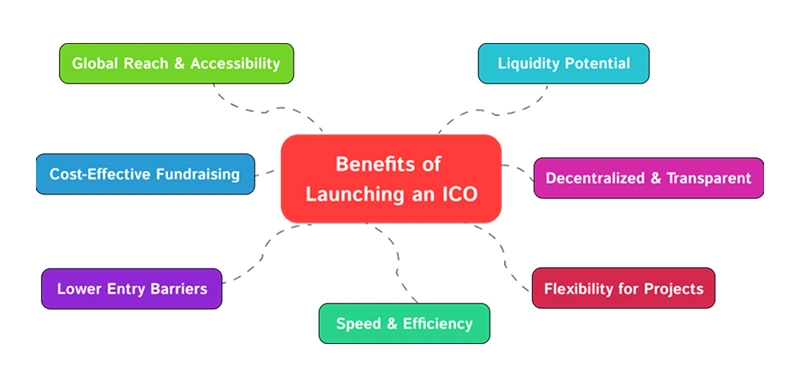
- Global Reach & Accessibility
Global accessibility of ICOs is one of the main benefits. Traditional forms of raising funds are limited by location or government regulations. But by utilizing ICOs, investors from any part of the world can participate and contribute to the project.
- Cost-Effective Fundraising
Undoubtedly, ICOs are a more cost-effective option than traditional fundraising options, such as IPOs. That’s because the high costs associated with legalities, third-party commissions, and compliance in traditional systems get reduced with ICOs.
- Lower Entry Barriers
ICOs remove many of the traditional barriers to entry for both startups and investors. And project owners don’t need to go through intermediaries or third parties to get funding, and investors can participate with small amounts of cryptocurrency. This makes ICOs a more inclusive and accessible option.
- Liquidity Potential
Once tokens are listed on cryptocurrency exchange platforms, they can be traded freely, which gives early investors the potential for liquidity. This is an attractive feature, as it allows participants to buy or sell tokens on the open market, unlike traditional equity investments that often require years to exit.
- Decentralized & Transparent
Because ICOs are based on blockchain technology, every transaction is recorded on a public ledger. This transparency builds trust among investors, as it allows anyone to verify how funds are being raised and allocated. The decentralized nature of blockchain also reduces the dependence on third parties, which gives projects and investors more control.
- Flexibility for Projects
ICOs tend to provide unmatched adaptability, which lets companies customize token models according to individual needs and demands. And, ICOs serve a wide range of goals, from security tokens, which indicate ownership, to utility tokens, which allow complete access to a business.
- Speed & Efficiency
Compared to the traditional ways of raising funds, ICOs cut down the time required for collecting money for projects. And, blockchain technology allows several parts of the fundraising process to be automated, which facilitates a simplified process of raising funds.
Key Steps to Launch an ICO
Once you are aware of what an ICO is and how it works, you should know how to launch it. Here are the steps involved in launching a successful ICO:
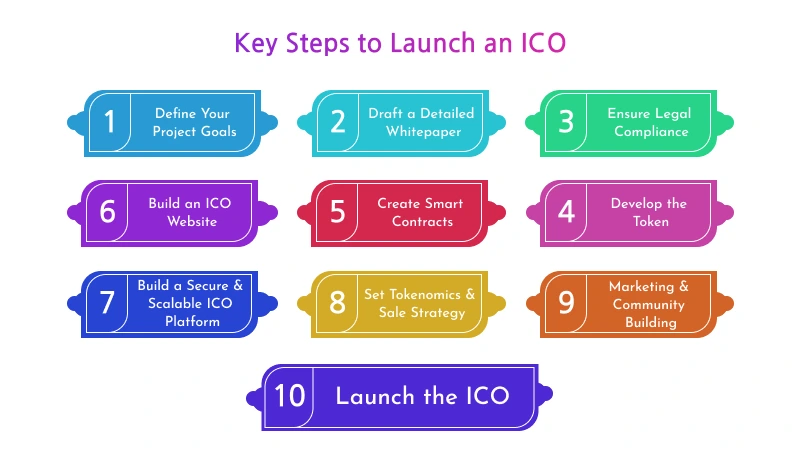
Step 1: Define Your Project Goals
Setting clear goals is the first step to launching an ICO. In this, you need to outline the product’s goals, its problem-solving approach, and anticipated results. For this, you need to conduct thorough market research and competitor analysis such that you find market opportunities that act as a strong base for your project.
Step 2: Draft a Detailed Whitepaper
The whitepaper for your ICO plays an important role. It grabs the attention of potential investors towards your project. Basically, it is a document that describes the prevailing issue within the market and provides the solutions that address it. Ensure that you include some elements in your whitepaper, like:
- Project overview and vision
- A detailed description
- Technical architecture
- Tokenomics (supply, distribution, use)
- Clear strategy for all allocations
- Roadmap and milestones
- Team and advisors
- Legal disclaimers
Step 3: Ensure Legal Compliance
Launching an ICO in 2025 requires adherence to rules and regulations. It is important that AML and KYC rules are followed for your ICO. If you are a newbie, ensure that you get legal help from experts so that you can easily obtain permits, prepare papers, and more.
Step 4: Develop the Token
Next, you will need to create a token that represents your project’s value or use case. Most ICOs use Ethereum and follow the ERC-20 standard, which ensures that your token can work seamlessly with wallets and exchanges. You will need to define things such as:
- Token name
- Symbol
- Total supply
- Decimal places
- Transfer functions
Step 5: Create Smart Contracts
Smart contracts are self-executing agreements on the blockchain that automate the ICO process. They manage:
- Token distribution
- Fund collection
- Investor whitelisting or restrictions
- Refund rules if the ICO fails to meet the soft cap
Ensure that these contracts are carefully coded and audited for security. That’s because once these are deployed on the blockchain, they can’t be changed.
Step 6: Build an ICO Website
Next, you need to work on building a professional and informative website for your ICO. This website is often the first point of contact for potential investors; thus, it needs to communicate your project’s goals clearly. It should include key elements such as the project overview, tokenomics, whitepaper download, team bios, roadmap, FAQs, and contact information.
Step 7: Build a Secure & Scalable ICO Platform
In this step, you need to create an ICO platform that’s intuitive, secure, and scalable, where users can register, verify their identities, and participate in the token sale. Security is important at this stage; thus, consider implementing measures like 2FA, SSL encryption, DDoS protection, and regular smart contract audits.
Step 8: Set Tokenomics & Sale Strategy
Tokenomics acts as a blueprint for your token. It defines how tokens are created, distributed, and used within your ecosystem. You will need to define the token’s utility, such as governance rights, staking benefits, and more. Other than this, your sales strategy will outline key phases of the ICO, pricing tiers, hard and soft caps, and more for your ICO.
Step 9: Marketing & Community Building
No ICO can succeed without strong marketing and an engaged community. This step involves creating awareness and trust around your project through a marketing campaign that may include:
- Social media outreach
- Influencer partnerships
- Press release
- Content creation
- Crypto media placements
Step 10: Launch the ICO
Once every step is completed, it is time to officially launch the ICO. This is when your platform goes live, and investors can start purchasing tokens. Also, you need to monitor the ICO process closely and ensure everything runs smoothly.
Wrapping Up
That’s it for this blog!
Launching a successful ICO in 2025 takes more than just a great idea. It requires a clear vision, strong technical planning, legal awareness, community trust, and a well-executed marketing strategy.
If you are serious about taking your blockchain project from concept to launch and want to avoid costly mistakes, working with the right development partner can make all the difference.
That’s why Coin Developer India stands out as the best ICO development agency. With years of experience, end-to-end solutions, and a deep understanding of crypto trends, we help entrepreneurs turn ideas into successful ICOs.
Ready to take your project to the next level? Connect with our experts today!


